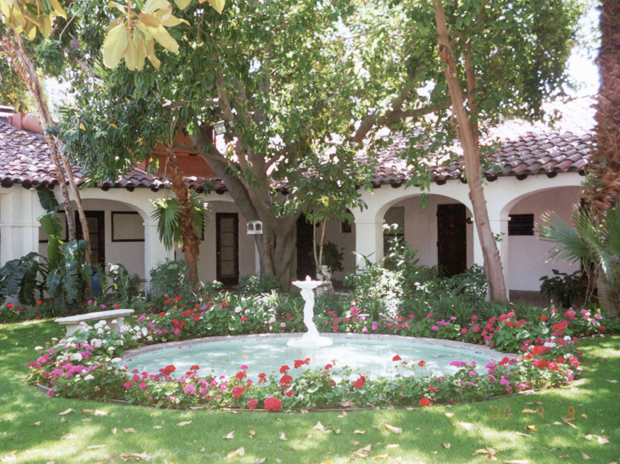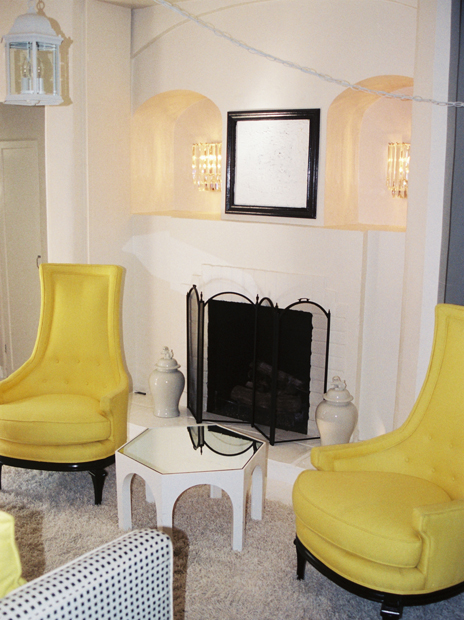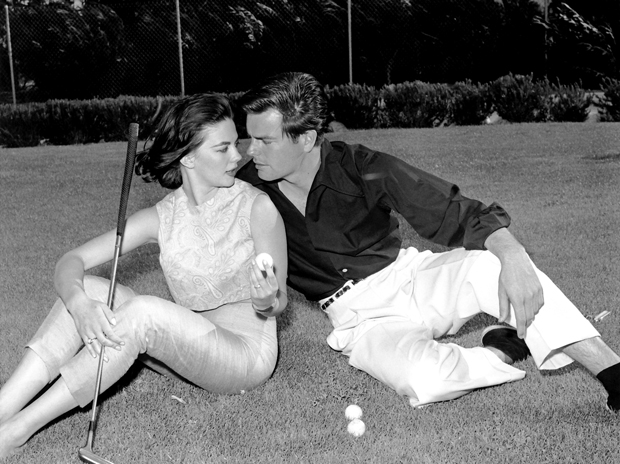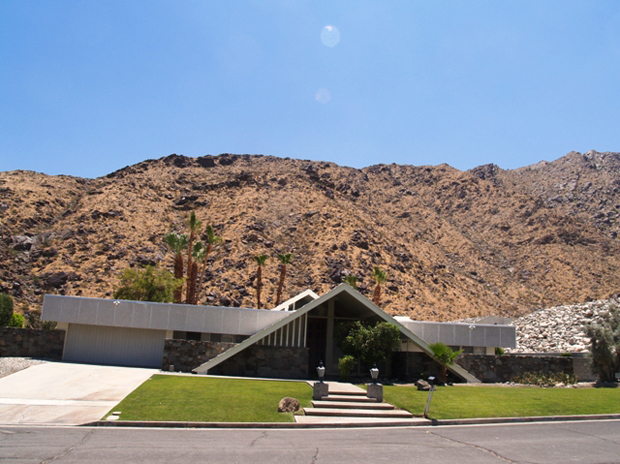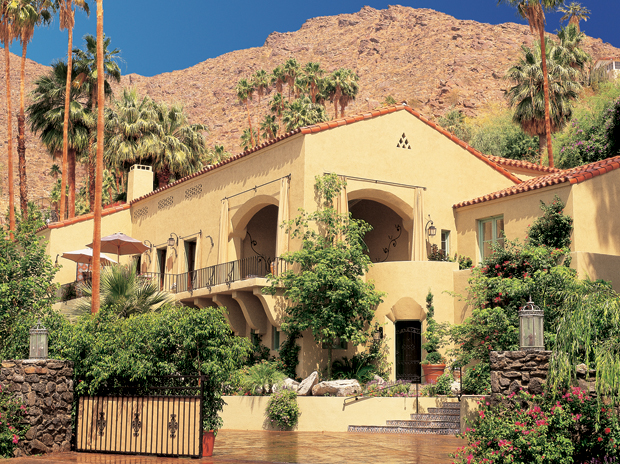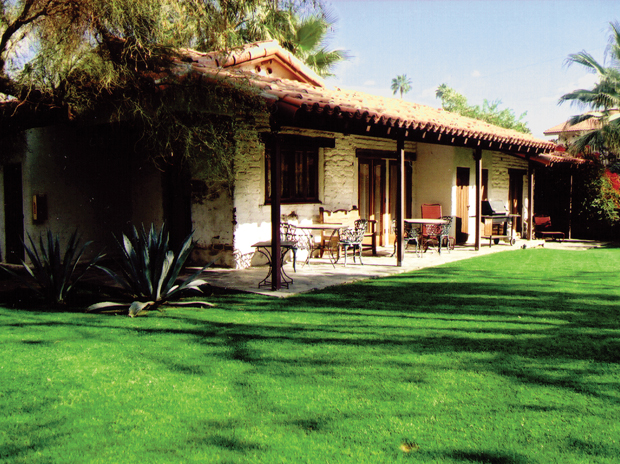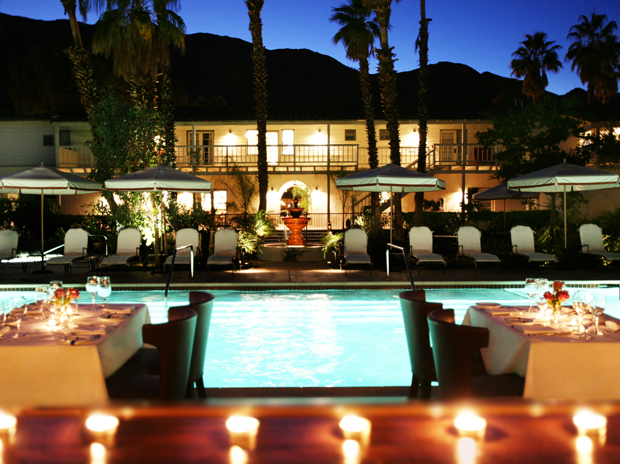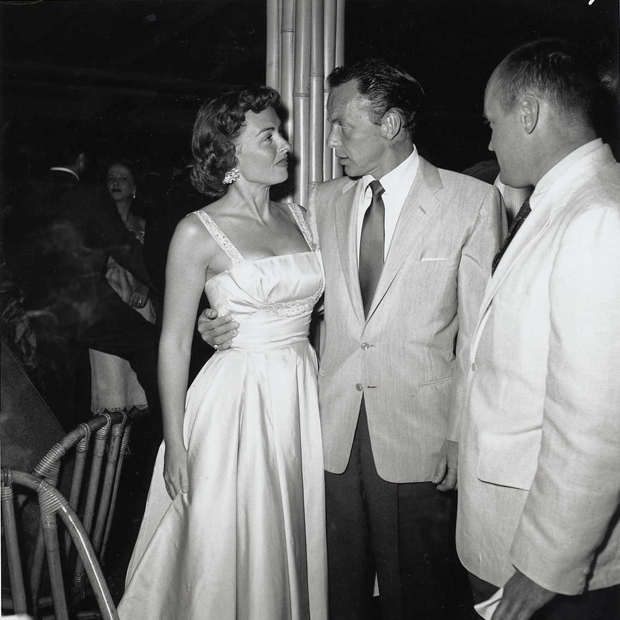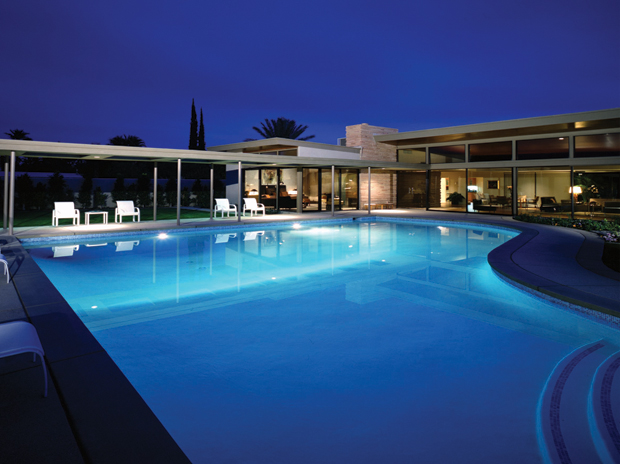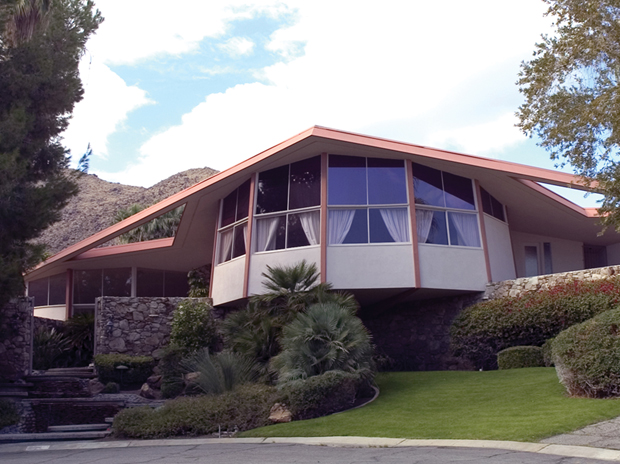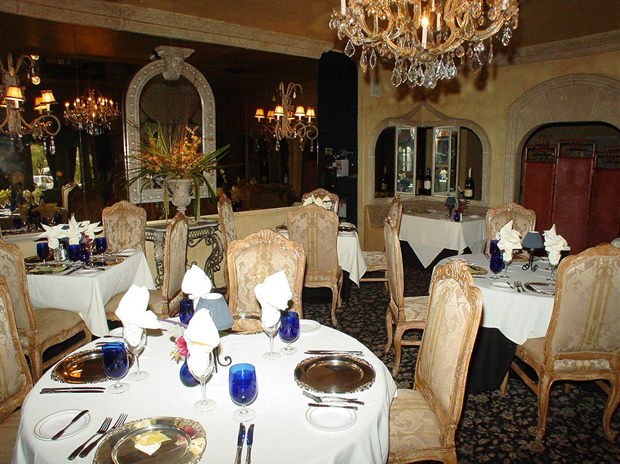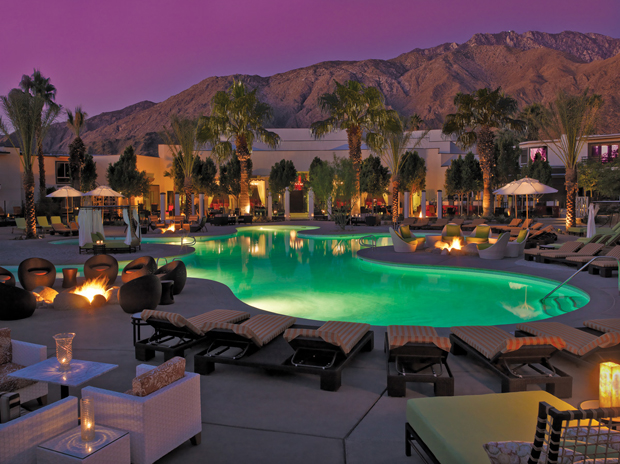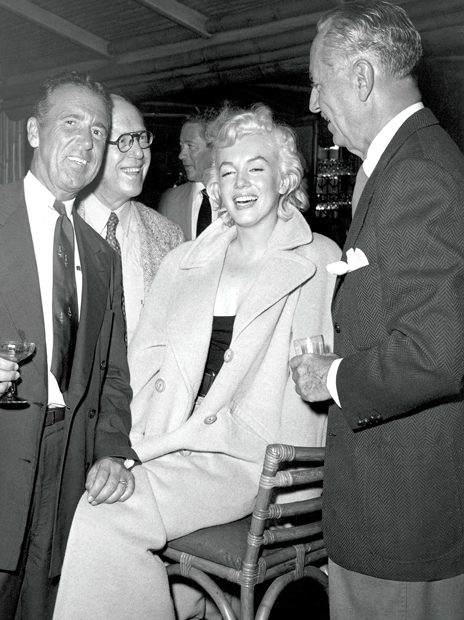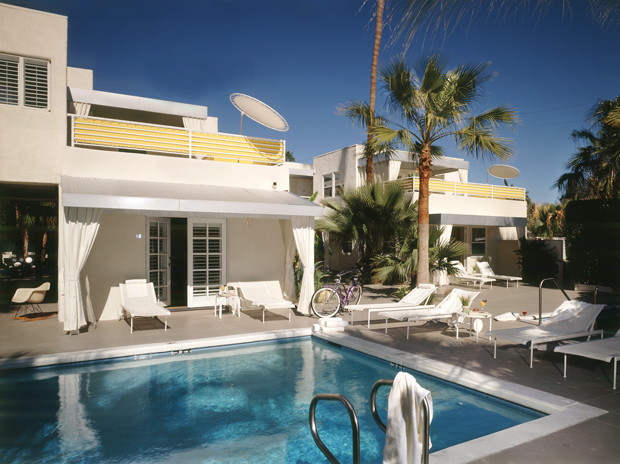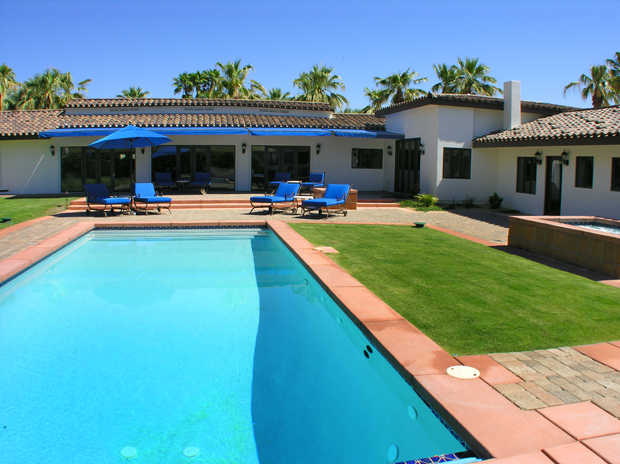“Hollywood has always been a cage... a cage to catch our dreams.”
- John Huston
With the sharpest and most instant wit, with never a hair out of place and dressed from head to foot in the latest luxuries, our stars have strode and smouldered across both our screens and the collective consciousness for as long as we can remember.
Forty foot high, at once as big as houses and as fragile as the screen on which they are held captive, these gods of the twentieth century have both lived in and beyond our wildest dreams - their own lives often more outlandishly glamorous than those of the characters they play.
The reality of Hollywood, a machine to frame our fantasies, is one from which even its anointed sons need respite - but to where do the glittering vessels of fantasy, those dedicated to its fabrication, go to escape their own reality.
Intriguingly, during the golden age of the eternally inward-looking home of the movies, the answer seems perhaps to have come from the movies themselves - the Western. The vast emptiness and limitless possibility of the desert plains and the eagle circled mountain passes of the great American West had been a staple of America’s great gilded myth-machine since the silent pictures of the 1920s. The telling and retelling of the conquering of the west’s savage wilderness is indeed a cornerstone of American identity.
Seeking to get away from the rigours of tinsel town, its biggest stars ventured into this symbolically fertile and climatically arid terrain. The first residents of the awe-inspiring Coachella Valley were the Cahuilla Indians some 2,000 years ago, but by 1884, the first permanent non-Indian settler had arrived in what was now known as Palm Springs. Judge John Guthrie McCallum of San Francisco brought both his family and water to the valley, building a sophisticated aqueduct.
Having initially gained fashionable Twentieth Century notoriety as a health resort for wealthy sufferers of conditions alleviated by its dry heat, by the 1920s, it had become a haven for Hollywood stars seeking the same winter sun. The seclusion and the privacy afforded by the small, still unknown, desert town and the sense of unbridled space fuelled its growth, and by 1938 it had been made into an incorporated municipality.
With the advent of the strict discipline of the studio system and its infamous “Two-Hour Rule”, where actors were contractually obliged to be within a two hour radius of the studio in the event of urgent filming commitments, Palm Springs’ popularity in Hollywood continued to intensify through the pre-war “talkies” boom.
A string of ultra luxury hotels, restaurants and bars sprung up to service the town’s ever growing contingent of show business stars and wealthy holiday makers, each of whom settled on their own favourite nightspots and hangouts in what was becoming an international society sensation.
One of the first true international movie mega stars, Charlie Chaplin made the Casa Cody his personal fiefdom. This classic adobe hacienda ranch was founded by the cousin of none other than the cousin of Wild West legend Buffalo Bill Cody, Harriet, herself a renowned Hollywood socialite and beauty, and was fringed by the natural freshness of citrus and bougainvilleas.
Iconic names in Hollywood folklore such as the Colony Palms, a Spanish Colonial style hotel with a scandalously colourful past later renamed as The Howard Manor and a favourite amongst the young acting tyros. Mediterranean villa The Willows boasted a glitteringly eclectic guest list that included Albert Einstein and Clark Gable. The latter was also a regular at bungalow hideaway the Viceroy Palm Springs, rubbing illustrious shoulders with Joan Crawford and Bing Crosby, amongst others.
Perhaps the most celebrated Palm Springs venue during the golden years of Hollywood, and therefore the town’s own boom period, the Ingleside Inn was also one of the oldest. Originally constructed in 1925 as a lavish Spanish colonial style complex in the shade of the San Jacinto Mountains by society industrialists the Humphrey Birge family, it was transformed into a twenty room hotel by the subsequent owner, Ruth Hardy.
Adhering to the first rule of luxury, exclusivity, her Ingleside Inn was a private members club, whose invitation only policy made even celebrity reservations redundant. The Ingleside’s small but renowned restaurant, Melvyn’s, was for the exclusive use of hotel guests and any diners invited by them had first to be approved by the redoubtable Ms. Hardy.
This most intimate sense of elite selection made both the Ingleside and Melvyn’s truly unique. Frank Sinatra and his self-styled Rat Pack of carousing actors, singers and comedians held regular and legendary parties there, while other guests included Greta Garbo, Elizabeth Taylor, Howard Hughes, and Salvador Dali. It was very soon transformed into one of the most exclusive and influential nightspots in the United States.
Soon, stars and society grandees were no longer content to stay for dinner or even overnight and began to commission the design and construction of extravagant private residences. A perfect storm of breathtaking natural beauty, the extreme disposable wealth of the cream of America’s creative class and their competitive sense of style brought the brightest architectural and design talent to Palm Springs.
Having made his first million, Sinatra gave talented young architect E. Stewart Williams his first commission - to build what become known as Twin Palms, a desert hideaway replete with a piano shaped pool, which on completion in 1948 became an icon of its era. As the United States exploded triumphantly out of the privations and horror of the Second World War, Hollywood and its new generation of stars leapt headfirst into the bright new dawn.
In these post-war years, Palm Springs came to be an international byword for the kind of glamorous abandon and seductive hedonism that the new wealth and beauty of its new most celebrated residents brought to their eponymous residential neighbourhood, Movie Colony.
Stories of poolside parties at hot spots such as the El Mirador and tennis and drinks at the Racquet Club regularly featured in the gossip column and scandal rags and came to represent a halcyon fantasy of eternal and blissful leisure in the minds of millions of fans and followers. The Riviera Resort almost instantly grabbed the headlines and the celebrity clientele on opening its doors in 1959. Its wheel-like plan radiated luxury cabins and chalets out from the vastly opulent central pool and restaurant area and cross-pollinated friendships amongst the high power players and celebrity couples as they strolled casually from brunch to soiree.
This boom, both in terms of the city’s enduring popularity with the Hollywood aristocracy and as an international luxury lifestyle centre, has continued until the present day. Its legendary hospitality venues have enjoyed a modern spell of retro nostalgia, refitted and rejuvenated for savvy new generations of stars and elite vacationers alike, while many classic Palm Springs residences have been transformed into stunning new attractions such as Copley’s Restaurant on the site of Cary Grant’s former estate.
The extraordinary flurry of construction that took place in Palm Springs’ heyday represented something of a boutique architectural revolution, where the creative ambition of the young innovative architects attracted to the starry commissions was matched by that of their clients.
The breathtaking natural setting and the open and fluid conviviality of the luxurious Palm Springs lifestyle were harnessed by a new generation of architects and designers working in state of the art industrial materials and inspired by the modernist tenets of the International Style. Coachella Valley’s limitless expanses of desert and sky and the enormity of the mountains that mediate them, effortlessly integrating these infinities, seem to have inspired the unforgettable buildings of what became known as the Desert Modern style.
Inspired by the German Bauhaus aesthetic, the work of such contemporary luminaries as Williams, Richard Neutra, John Lautner, and Albert Frey, were beautiful, often box like structures sketched in concrete, steel and plane upon plane of sheer glass. Featuring open design-plans, wall to wall carpeting, air-conditioning and the must have luxury symbol - a swimming pool, they created a sense of modern life as being simultaneously state of the art and no more than a part of the landscape in which it was set - much like the natural trinity of desert-mountain-sky that boomed silently all around.
Frey designed the City Hall and airport, the iconic Movie Colony Hotel, and apartment building the Villa Hermosa, in which Marilyn Monroe and Truman Capote stayed. Richard Neutra was most famously responsible for the explosion of ideas and sense of a functioning optimism found in the clean lines and open views of the truly iconic Kaufmann House.
Perhaps the most radical of these Palm Springs masterpieces is the otherworldly, deceptive and ultimately stunning project that John Lautner realised for acclaimed designer and Palm Springs resident Arthur Elrod. This extraordinary residence, structured around the breathtaking simplicity of a vast circular living area that incorporates a seamless transition from inside to outside, makes audacious use of an interior-exterior pool to bridge the space and incorporates the enormous boulders of the setting to integrate itself with the natural world beyond.
If Hollywood beams our fantasies into the simulated darkness of our entertainment, then Palm Springs is the place where those players, those gods that enact them, may go to dream themselves. At once outside and inside, at once apart from and deeply embedded in its natural environment, modern classics such as the Elrod House created the space in which those dreams may be caught and left to breathe freely.
- Benjamin Stewart
Palm Springs
Address: Palm Springs, 92262
Website: www.visitpalmsprings.com
- John Huston
With the sharpest and most instant wit, with never a hair out of place and dressed from head to foot in the latest luxuries, our stars have strode and smouldered across both our screens and the collective consciousness for as long as we can remember.
Forty foot high, at once as big as houses and as fragile as the screen on which they are held captive, these gods of the twentieth century have both lived in and beyond our wildest dreams - their own lives often more outlandishly glamorous than those of the characters they play.
The reality of Hollywood, a machine to frame our fantasies, is one from which even its anointed sons need respite - but to where do the glittering vessels of fantasy, those dedicated to its fabrication, go to escape their own reality.
Intriguingly, during the golden age of the eternally inward-looking home of the movies, the answer seems perhaps to have come from the movies themselves - the Western. The vast emptiness and limitless possibility of the desert plains and the eagle circled mountain passes of the great American West had been a staple of America’s great gilded myth-machine since the silent pictures of the 1920s. The telling and retelling of the conquering of the west’s savage wilderness is indeed a cornerstone of American identity.
Seeking to get away from the rigours of tinsel town, its biggest stars ventured into this symbolically fertile and climatically arid terrain. The first residents of the awe-inspiring Coachella Valley were the Cahuilla Indians some 2,000 years ago, but by 1884, the first permanent non-Indian settler had arrived in what was now known as Palm Springs. Judge John Guthrie McCallum of San Francisco brought both his family and water to the valley, building a sophisticated aqueduct.
Having initially gained fashionable Twentieth Century notoriety as a health resort for wealthy sufferers of conditions alleviated by its dry heat, by the 1920s, it had become a haven for Hollywood stars seeking the same winter sun. The seclusion and the privacy afforded by the small, still unknown, desert town and the sense of unbridled space fuelled its growth, and by 1938 it had been made into an incorporated municipality.
With the advent of the strict discipline of the studio system and its infamous “Two-Hour Rule”, where actors were contractually obliged to be within a two hour radius of the studio in the event of urgent filming commitments, Palm Springs’ popularity in Hollywood continued to intensify through the pre-war “talkies” boom.
A string of ultra luxury hotels, restaurants and bars sprung up to service the town’s ever growing contingent of show business stars and wealthy holiday makers, each of whom settled on their own favourite nightspots and hangouts in what was becoming an international society sensation.
One of the first true international movie mega stars, Charlie Chaplin made the Casa Cody his personal fiefdom. This classic adobe hacienda ranch was founded by the cousin of none other than the cousin of Wild West legend Buffalo Bill Cody, Harriet, herself a renowned Hollywood socialite and beauty, and was fringed by the natural freshness of citrus and bougainvilleas.
Iconic names in Hollywood folklore such as the Colony Palms, a Spanish Colonial style hotel with a scandalously colourful past later renamed as The Howard Manor and a favourite amongst the young acting tyros. Mediterranean villa The Willows boasted a glitteringly eclectic guest list that included Albert Einstein and Clark Gable. The latter was also a regular at bungalow hideaway the Viceroy Palm Springs, rubbing illustrious shoulders with Joan Crawford and Bing Crosby, amongst others.
Perhaps the most celebrated Palm Springs venue during the golden years of Hollywood, and therefore the town’s own boom period, the Ingleside Inn was also one of the oldest. Originally constructed in 1925 as a lavish Spanish colonial style complex in the shade of the San Jacinto Mountains by society industrialists the Humphrey Birge family, it was transformed into a twenty room hotel by the subsequent owner, Ruth Hardy.
Adhering to the first rule of luxury, exclusivity, her Ingleside Inn was a private members club, whose invitation only policy made even celebrity reservations redundant. The Ingleside’s small but renowned restaurant, Melvyn’s, was for the exclusive use of hotel guests and any diners invited by them had first to be approved by the redoubtable Ms. Hardy.
This most intimate sense of elite selection made both the Ingleside and Melvyn’s truly unique. Frank Sinatra and his self-styled Rat Pack of carousing actors, singers and comedians held regular and legendary parties there, while other guests included Greta Garbo, Elizabeth Taylor, Howard Hughes, and Salvador Dali. It was very soon transformed into one of the most exclusive and influential nightspots in the United States.
Soon, stars and society grandees were no longer content to stay for dinner or even overnight and began to commission the design and construction of extravagant private residences. A perfect storm of breathtaking natural beauty, the extreme disposable wealth of the cream of America’s creative class and their competitive sense of style brought the brightest architectural and design talent to Palm Springs.
Having made his first million, Sinatra gave talented young architect E. Stewart Williams his first commission - to build what become known as Twin Palms, a desert hideaway replete with a piano shaped pool, which on completion in 1948 became an icon of its era. As the United States exploded triumphantly out of the privations and horror of the Second World War, Hollywood and its new generation of stars leapt headfirst into the bright new dawn.
In these post-war years, Palm Springs came to be an international byword for the kind of glamorous abandon and seductive hedonism that the new wealth and beauty of its new most celebrated residents brought to their eponymous residential neighbourhood, Movie Colony.
Stories of poolside parties at hot spots such as the El Mirador and tennis and drinks at the Racquet Club regularly featured in the gossip column and scandal rags and came to represent a halcyon fantasy of eternal and blissful leisure in the minds of millions of fans and followers. The Riviera Resort almost instantly grabbed the headlines and the celebrity clientele on opening its doors in 1959. Its wheel-like plan radiated luxury cabins and chalets out from the vastly opulent central pool and restaurant area and cross-pollinated friendships amongst the high power players and celebrity couples as they strolled casually from brunch to soiree.
This boom, both in terms of the city’s enduring popularity with the Hollywood aristocracy and as an international luxury lifestyle centre, has continued until the present day. Its legendary hospitality venues have enjoyed a modern spell of retro nostalgia, refitted and rejuvenated for savvy new generations of stars and elite vacationers alike, while many classic Palm Springs residences have been transformed into stunning new attractions such as Copley’s Restaurant on the site of Cary Grant’s former estate.
The extraordinary flurry of construction that took place in Palm Springs’ heyday represented something of a boutique architectural revolution, where the creative ambition of the young innovative architects attracted to the starry commissions was matched by that of their clients.
The breathtaking natural setting and the open and fluid conviviality of the luxurious Palm Springs lifestyle were harnessed by a new generation of architects and designers working in state of the art industrial materials and inspired by the modernist tenets of the International Style. Coachella Valley’s limitless expanses of desert and sky and the enormity of the mountains that mediate them, effortlessly integrating these infinities, seem to have inspired the unforgettable buildings of what became known as the Desert Modern style.
Inspired by the German Bauhaus aesthetic, the work of such contemporary luminaries as Williams, Richard Neutra, John Lautner, and Albert Frey, were beautiful, often box like structures sketched in concrete, steel and plane upon plane of sheer glass. Featuring open design-plans, wall to wall carpeting, air-conditioning and the must have luxury symbol - a swimming pool, they created a sense of modern life as being simultaneously state of the art and no more than a part of the landscape in which it was set - much like the natural trinity of desert-mountain-sky that boomed silently all around.
Frey designed the City Hall and airport, the iconic Movie Colony Hotel, and apartment building the Villa Hermosa, in which Marilyn Monroe and Truman Capote stayed. Richard Neutra was most famously responsible for the explosion of ideas and sense of a functioning optimism found in the clean lines and open views of the truly iconic Kaufmann House.
Perhaps the most radical of these Palm Springs masterpieces is the otherworldly, deceptive and ultimately stunning project that John Lautner realised for acclaimed designer and Palm Springs resident Arthur Elrod. This extraordinary residence, structured around the breathtaking simplicity of a vast circular living area that incorporates a seamless transition from inside to outside, makes audacious use of an interior-exterior pool to bridge the space and incorporates the enormous boulders of the setting to integrate itself with the natural world beyond.
If Hollywood beams our fantasies into the simulated darkness of our entertainment, then Palm Springs is the place where those players, those gods that enact them, may go to dream themselves. At once outside and inside, at once apart from and deeply embedded in its natural environment, modern classics such as the Elrod House created the space in which those dreams may be caught and left to breathe freely.
- Benjamin Stewart
Palm Springs
Address: Palm Springs, 92262
Website: www.visitpalmsprings.com
Palm Springs,






